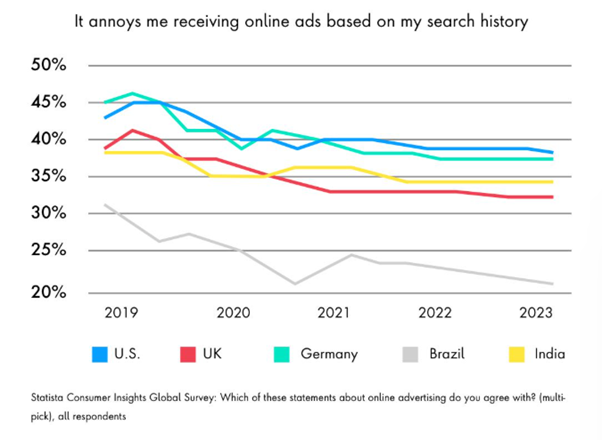The e-commerce sector has undergone dynamic changes for several years, and 2025 is no exception. The pandemic urged the FMCG sector to come online. However, the emerging brands and consumers were also quick to adapt to the new trend.
Despite the frontline challenges and opportunities, e-commerce has shown remarkable resilience, navigated the eccentric period and now grown at a reasonable pace. This resilience is a testament to the adaptability and strength of the e-commerce sector.
Speaking of eCommerce growth, the UK registered one of the highest revenue numbers among all countries experiencing e-commerce growth. In 2025, the UK is likely to achieve an ecommerce revenue of £110.27 billion.
The chief Growth Factors
Three principal factors contribute to the spontaneous growth of the e-commerce sector. Firstly, most progressive countries have had a stable political environment since 2018. This stability has created a thriving ground for new businesses, instilling a sense of security and confidence in the entrepreneurial landscape.
Secondly, there is a globally vibrant private economy, which significantly promotes job creation and economic expansion. Consequently, the purchasing power of the people is also growing, resulting in a greater affinity for consumer products.
Lastly, there has been an exponential growth of the online shopping population and social commerce.
Over 2.14 billion people shop online. In other words, 27% of the global population are online shoppers. The best part is that the e-commerce frenzy is not limited to any specific buyer persona. It's a community where baby Boomers, Millennials, and the following generations are all equal participants in online shopping.
Global Growth Scalability
2025 is a landmark year in terms of ecommerce growth. The global e-commerce sales reached a new high this year, amounting to 50,89,53,04,79,040.00 Pound sterling. A staggering figure that prompts an ongoing transition from brick-and-mortar stores to online sites.
The availability of better 3PL vendors offering affordable rates and a global network helps a lot of ecommerce companies thrive. One of the eminent brands in the modern logistics circuit is Radius. Their fleet and connectivity solutions can help you scale your ecommerce business easily.
From private cars to daily groceries, almost everything is now available for purchase online.
What Prompted This Growth?
The pandemic took a significant toll, leading to regional segregation and social distancing among people. Therefore, the brick-and-mortar sales came to a standstill. The market witnesses a void. However, emerging online brands were not late to realize this chance to penetrate the FMCG market and make their mark.
Unique e-commerce brands, such as Best Buy, Woolworths, and Home Depot, made their daunting entries into the ecommerce market in 2019-20. However, some cities were more preferred by new brands due to the stable economy and stable political environment.
A Scalable and Round-The-Clock Growth!
Cleverence observes that e-commerce businesses thrive in a stable and statutory environment. In such locations, you won’t find traditional e-commerce brands growing alone. Amazon, eBay, and other major brands undoubtedly grew. However, small-scale physical brands, often located regionally, also started turning online before the pandemic.
Under the Enterprise Finance Guarantee Scheme, local governments also assisted these thriving physical retail brands in transitioning their businesses online. This is how the remarkable ecommerce ecosystem developed in many destinations.
Other Trends Changing the E-Commerce Landscape
Let’s explore the other trends shaping the ecommerce landscape. Based on consumer research and retail industry insights, these trends also played a decisive role in evolving ecommerce:
1. Gen-AI, zero-click search makes ecommerce conversational
In 2025, many ecommerce companies will roll out conversational search tools. Take the example of Homes & Villas by Marriott Bonvoy. They developed an AI search tool that utilizes NLP to assist users in finding relevant accommodation options based on specific criteria.
How are consumers reacting to the swift commercial adoption of generative AI? Around 27% of the consumers are very excited about AI’s ability to trim and streamline search results to match their choices and preferences.
This rapid shift to intent-based search and generative AI may take longer to infiltrate the websites of consumer brands. Only 43% of the consumers expect brands to deploy generative AI to enhance the consumer experience.
2. Media Networks Would Be Instrumental To The Incremental Growth
Media networks are gaining access to big data, which enables them to personalize brand messages. Surprisingly, consumers agree to that easily. In the future, media networks will also continue to cater to market needs for branded manufacturers and consumer products.
On that note, sources project that retail media will account for 15% of the ad revenue by 2028. Hence, eclipsing television as an advertising channel.

Source: publicissapient.com
The data suggests that consumers might still not like targeted ads naturally. However, current statistics also indicate that their expectations and preferences for targeted and customized e-commerce ads are expected to grow further.
Ecommerce Trends To Become Popular Later in 2025
2025 marks a year of adaptation and transition in the e-commerce domain. The main trends that shaped the way businesses work in this sphere will give way to new trends:
1. Subscription-Based Models Will Flourish
Sectors such as beauty, entertainment, and food delivery are expected to see a significant rise in subscription-based models. The current consumption trends validate these growth trends.
Consumers have become accustomed to subscribing to everyday products. Hence, this model is expected to become more popular in the days to come.
2. Ecommerce and Sustainability
Most consumers expect ecommerce brands to focus more on sustainability and make their business practices more transparent. The ecommerce brands that focused on transparency and sustainability in 2025 have gained more traction.
3. Use of AI and IoT
AI and IoT tech have been instrumental in 2025. At first, there were search bots. Now, chatbots send personalized recommendations by default. From a business perspective, these models are not costly. Hence, small e-commerce brands can also benefit from these advantages.
Secondly, e-commerce brands also use IoT-based inventory management and pricing adjustments. In return, they enjoy better customer acquisition and higher sales.
Conclusion
In 2025, the growth of global ecommerce has been marked by quick growth, innovation, and adaptability. As shopping went online, mobile devices became retail outlets, and social media became the greatest brand endorsers.
The trends that emerged this year will shape the future of the global e-commerce sector as a whole. Moving forward, businesses in this sector will continue to embrace further changes.







